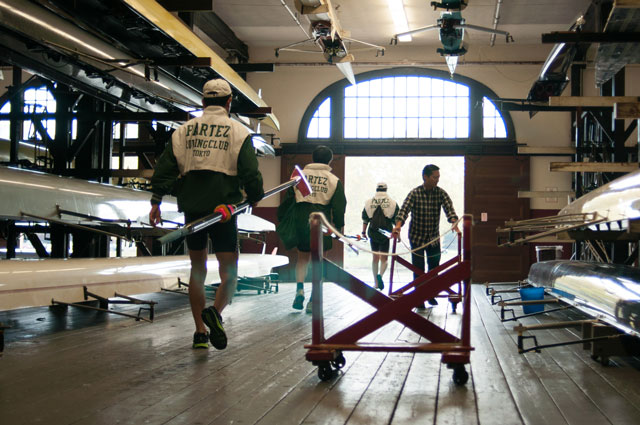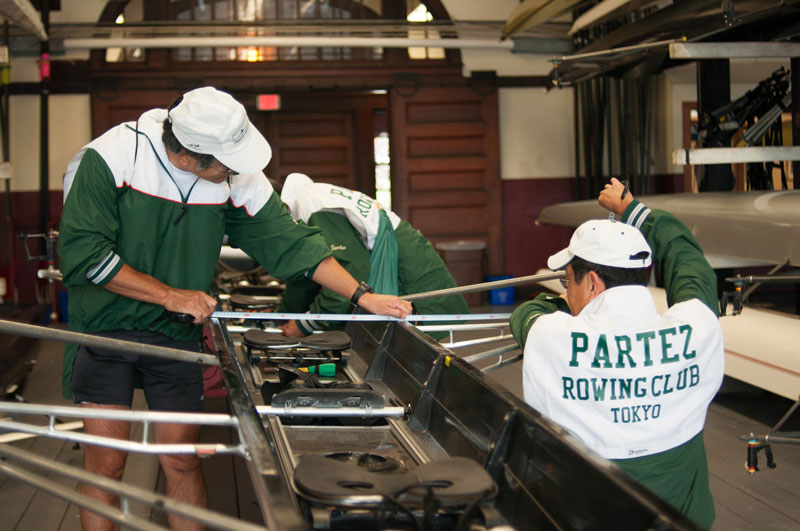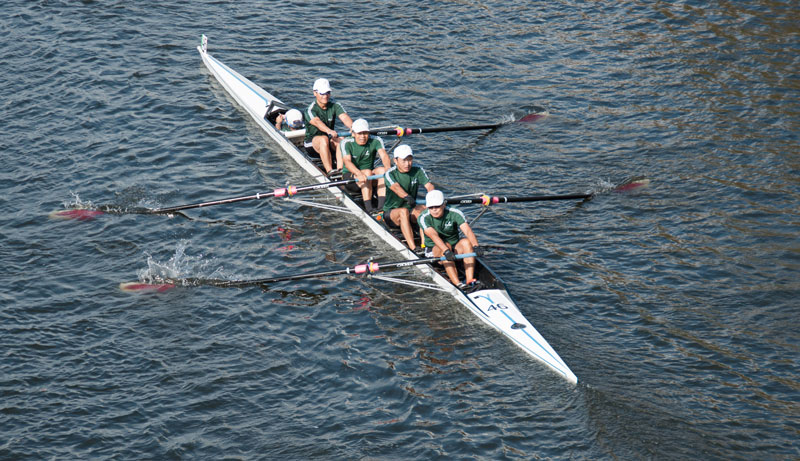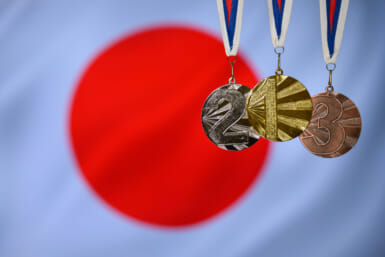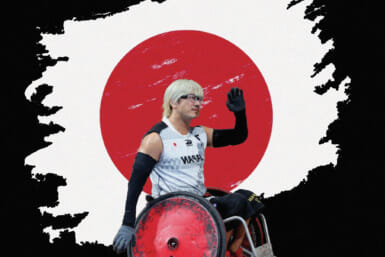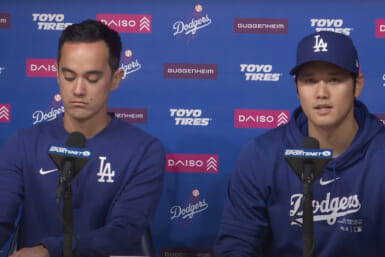This is not a story of winning. But it would be dishonest to say that the Partez Rowing Club took a 15-hour flight from Tokyo to Boston with only the intention to wear lane number 46, for the ninth time that they were competing in the Head of The Charles Regatta (HOCR).
Text and pictures by Yanshu Li
The HOCR is the largest two-day regatta in the world, and it celebrated its 50th anniversary this year.
At 10:46 am on Saturday, the crew of Partez Rowing Club was standing by for the Men’s Senior Master [50+] Fours. Four crewmembers and a cox, the Partez team was an average aged of 59. Their goal was to finish among the top half of the field of 54 clubs this year.
On Your Mark, Get Set…
Partez Rowing Club was launched in April 2000 in Tokyo. Unlike many other clubs that take their names from places or sponsors, they named the club by the French word partez.
“It means to go,” Nobu Ishizuka, 54, the youngest in this crew said. He is a Japanese-American. He joined the Partez Rowing Club in 2007.
“It’s used to be the starting commands of international regatta – ‘Etes-vous prets? Partez!’” said Ishizuka. “It means are you ready? Go!”
Takashi Nohmura, 58, works for a manufacturing company in Tokyo as a senior managing director, and he joined the club in 2004. He first started rowing in university 40 years ago and after graduating, he worked as a coach at the university level. He takes rowing seriously. As he explains semi-jokingly, “It’s the only thing I’ve done.” Other members of the team include Koichi Tanaka, the oldest member of the crew, who looks younger than his 65 years in a white T-shirt. Masayuki Kumagai, 60, who sports silver frame glasses, has grey sideburns and a warm smile. Kumagai says he likes the battle element of competitive rowing. “When the boats get really close, the blades clash. It’s fun for me,” He then added, “The beer is always good after training.”
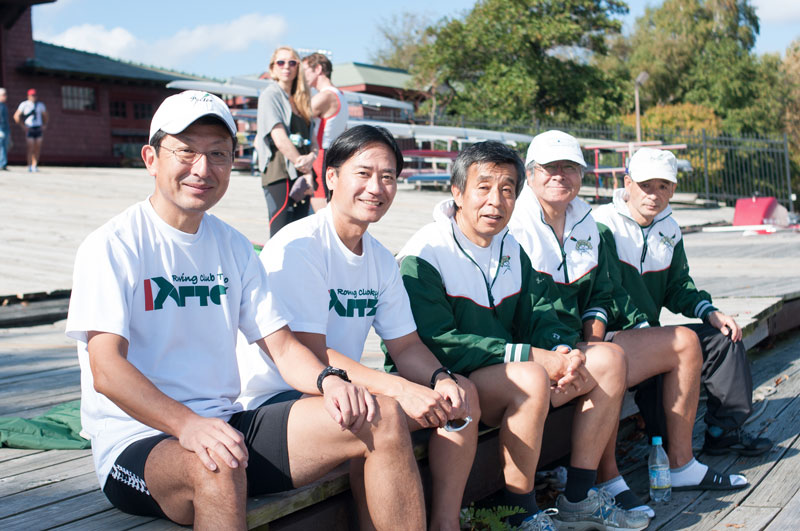
Members of the Partez Crew, from left to right Takashi Nohmura, Nobu Ishizuka, Koichi Tanaka, Masayuki Kumagai, and the cox Akio Kakishita
Back in Tokyo, this club has members in different levels. There are college students, and also experienced senior rowers. They train every Sunday at the Toda Olympic Rowing Course northwest of Tokyo. After training, they usually relax at a local soba noodle shop. “It’s a small, family-style Japanese restaurant that caters to the rowing community,” Ishizuka said.
Partez and the 50th HOCR
This year, Partez Rowing Club confirmed their crewmember list in June, and started training three hours a week. Learning how to cooperate in order to compete in the Regatta took a longer time.
“Last week, we finally felt like we are rowing well as a team, as a boat,” Mr. Ishizuka said. “It took a long time to find the proper rhythm and the pace for the members.”
HOCR is held on the Charles River, which features five major turns of the river between two lines. Coxswain Akio Kakishita, 61, appreciates the difficulty of the course.
“The course is very hard for a cox. And it’s really good for me to develop my coxing skills,” said Kakishita. He looked vigorous. He coxed the Japanese National Eight Oared Shell during the Montreal Olympics in 1976.
The crew arrived in Boston on October 16, only one day before the race. “But luckily our race is in the morning. If the race were in the afternoon, it will be tough,” Ishizuka said.
At 8:30 am on October 17, the group went to Newell Boathouse, on the southern bank of the Charles River. The crew picked the boat and examined it thoroughly, beginning to tweak the boat to their needs, rapidly getting into the zone. They fasten each screw, measure each part of the boat, and adjust the pace meter. After nearly one hour of meticulous examination, Partez’s boat was finally good to go.
At the same time, a crew from the UK named Thames came in, picked up a boat, and looked over it for fewer than five minutes before declaring it ready for the race.
Comparing with many other American clubs, Partez is young. They traveled all the way to America to challenge the curvy river. Ishizuka said, “the Head of the Charles Regatta is a special one for the Partez Rowing Club.” They cherish the quality of the event. They prefer the way it organized.
October 18 was a sunny day. At 10:46 am, the referee yelled to start.
The Partez crew rowed and stroked, under command of the cox Kakishita. They soon rowed under Boston University Bridge, muscles straining and faces fixed in fierce concentration, heading to the first turn. The first Master Fours club finished the three miles in 17 minutes and seven seconds. Partez rowed 21 minutes and three seconds. They didn’t make it to the top half.
“It was a tough race indeed. Our dream is over again,” Tanaka said after the race. During the race, Tanaka admitted to feeling almost powerless when they were surpassed by other crew, a feeling that Tanaka said, “I had not anticipated.”
“Coming up on Eliot Bridge, the crew was starting to run out of gas,” Kakishita said. “With a final expenditure of our energy we crossed the finish line.”
“This year, the weather was perfect for racing and, as usual, the atmosphere with all the international crews and university and school crews was terrific,” Ishizuka said after the race. He thought that they were quite challenged by the course and the speed of the other boats.
The crew sees rowing as a nice diversion. They can be away from their office lives and the pressures of their careers. And the challenges it brings are ways for them to seek higher goals.
“This is [the] metaphor for life itself,” Ishizuka said. “To become better.”
Yanshu Li is a graduate student at Boston University College of Communication. She is focusing on business and economics journalism. Her blog: http://yanshureports.com/ Photo portfolio: https://www.flickr.com/photos/leeys/

